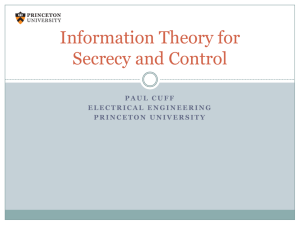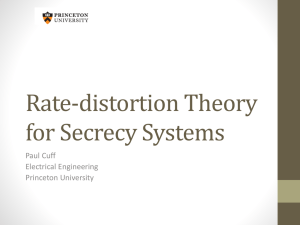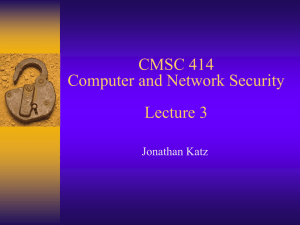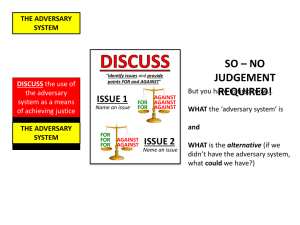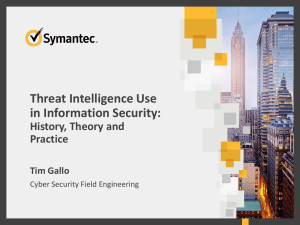Stanford ISL Colloquium, UC Berkeley Seminar, Bell Labs
advertisement
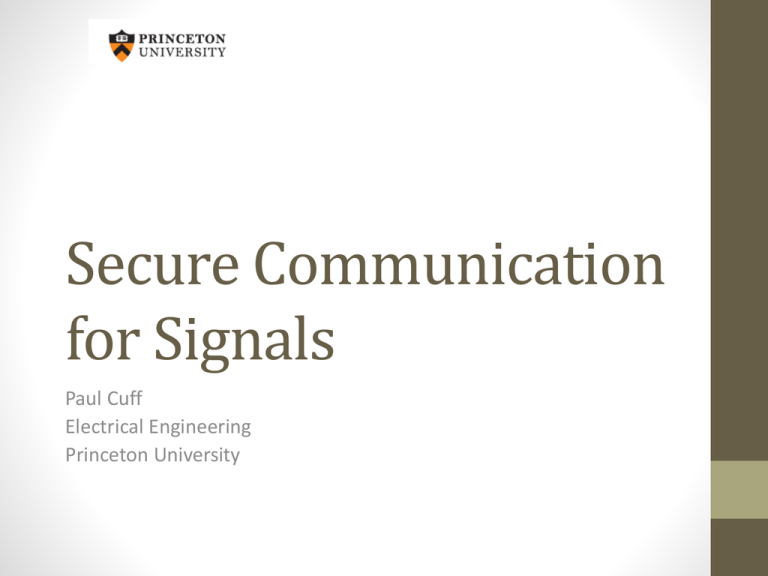
Secure Communication for Signals Paul Cuff Electrical Engineering Princeton University Information Theory Channel Coding Channel Source Coding Secrecy Source Main Idea • Secrecy for signals in distributed systems Distributed System Information Signal Message Action Node B Node A Adversary Attack • Want low distortion for the receiver and high distortion for the eavesdropper. • More generally, want to maximize a function Communication in Distributed Systems “Smart Grid” Image from http://www.solarshop.com.au Example: Rate-Limited Control Signal (sensor) Communication Signal (control) 00101110010010111 Attack Signal Adversary Example: Feedback Stabilization Controller Dynamic System Sensor Adversary Decoder 10010011011010101101010100101101011 Encoder Feedback • Data-rate Theorem [Baillieul, Brockett , Mitter, Nair, Tatikonda, Wong] Traditional View of Encryption Information inside Substitution Cipher to Shannon and Hellman A BRIEF HISTORY OF CRYPTO Cipher • Plaintext: Source of information: • Example: English text: Information Theory • Ciphertext: Encrypted sequence: • Example: Non-sense text: cu@ist.tr4isit13 Key Plaintext Encipherer Key Ciphertext Decipherer Plaintext Example: Substitution Cipher • Simple Substitution Alphabet ABCDE… Mixed Alphabet F Q SAR… • Example: • Plaintext: • Ciphertext: …RANDOMLY GENERATED CODEB… …DFLAUIPV WRLRDFNRA SXARQ… • Caesar Cipher Alphabet ABCDE… Mixed Alphabet DE FGH… Shannon Analysis • 1948 • Channel Capacity • Lossless Source Coding • Lossy Compression • 1949 - Perfect Secrecy • Adversary learns nothing about the information • Only possible if the key is larger than the information C. Shannon, "Communication Theory of Secrecy Systems," Bell Systems Technical Journal, vol. 28, pp. 656-715, Oct. 1949. Shannon Model • Schematic Key Plaintext Encipherer Key Ciphertext Decipherer Plaintext Adversary • Assumption • Enemy knows everything about the system except the key • Requirement • The decipherer accurately reconstructs the information For simple substitution: C. Shannon, "Communication Theory of Secrecy Systems," Bell Systems Technical Journal, vol. 28, pp. 656-715, Oct. 1949. Shannon Analysis • Equivocation vs Redundancy • Equivocation is conditional entropy: • Redundancy is lack of entropy of the source: • Equivocation reduces with redundancy: C. Shannon, "Communication Theory of Secrecy Systems," Bell Systems Technical Journal, vol. 28, pp. 656-715, Oct. 1949. Computational Secrecy • Assume limited computation resources • Public Key Encryption • Trapdoor Functions X 2 147 483 647 524 287 1 125 897 758 834 689 • Difficulty not proven • Can become a “cat and mouse” game • Vulnerable to quantum computer attack W. Diffie and M. Hellman, “New Directions in Cryptography,” IEEE Trans. on Info. Theory, 22(6), pp. 644-654, 1976. Information Theoretic Secrecy • Achieve secrecy from randomness (key or channel), not from computational limit of adversary. • Physical layer secrecy (Channel) • Wyner’s Wiretap Channel [Wyner 1975] • Partial Secrecy • Typically measured by “equivocation:” • Other approaches: • Error exponent for guessing eavesdropper [Merhav 2003] • Cost inflicted by adversary [this talk] Equivocation • Not an operationally defined quantity • Bounds: • List decoding • Additional information needed for decryption • Not concerned with structure Partial secrecy tailored to the signal SOURCE CODING SIDE OF SECRECY Our Framework • Assume secrecy resources are available (secret key, private channel, etc.) • How do we encode information optimally? • Game Theoretic Interpretation • • • • Eavesdropper is the adversary System performance (for example, stability) is the payoff Bayesian games Information structure First Attempt to Specify the Problem Decoder: Encoder: Key Information Message Node A Node B Adversary System payoff: . Action Attack Adversary: Secrecy-Distortion Literature • [Yamamoto 97]: • Proposed to cause an eavesdropper to have high reconstruction distortion • [Schieler-Cuff 12]: • Result: Any positive secret key rate greater than zero gives perfect secrecy. • Perhaps too optimistic! • Unsatisfying disconnect between equivocation and distortion. How to Force High Distortion • Randomly assign bins • Size of each bin is • Adversary only knows bin • Reconstruction of only depends on the marginal posterior distribution of Example (Bern(1/3)): Competitive Secrecy Decoder: Encoder: Key Information Message Node A Node B Adversary System payoff: . Action Attack Adversary: Performance Metric • Value obtained by system: • Objective • Maximize payoff Key Information Node A Message Node B Adversary Action Attack An encoding tool for competitive secrecy DISTRIBUTED CHANNEL SYNTHESIS Actions Independent of Past • The system performance benefits if Xn and Yn are memoryless. Channel Synthesis Q(y|x) Communication Resources Source • Black box acts like a memoryless channel • X and Y are an i.i.d. multisource Output Channel Synthesis for Secrecy Information Channel Synthesis Node A Node B Adversary Not optimal use of resources! Action Attack Channel Synthesis for Secrecy Information Channel Synthesis Node A Node B Un Adversary Reveal auxiliary Un “in the clear” Action Attack Point-to-point Coordination Synthetic Channel Q(y|x) Common Randomness Source Node A Message Node B • Related to: • • • • • Reverse Shannon Theorem [Bennett et. al.] Quantum Measurements [Winter] Communication Complexity [Harsha et. al.] Strong Coordination [C.-Permuter-Cover] Generating Correlated R.V. [Anantharam, Gohari, et. al.] Output Problem Statement Canonical Form Alternative Form • Does there exists a distribution: • Can we design: such that f g Construction • Choose U such that PX,Y|U = PX|U PY|U • Choose a random codebook Un J K C PX|U Yn PY|U Cloud Mixing Lemma [Wyner], [Han-Verdu, “resolvability”] Xn Information Theoretic Rate Regions Provable Secrecy THEORETICAL RESULTS Reminder of Secrecy Problem • Value obtained by system: • Objective • Maximize payoff Key Information Node A Message Node B Adversary Action Attack Payoff-Rate Function • Maximum achievable average payoff Theorem: • Markov relationship: Unlimited Public Communication • Maximum achievable average payoff Theorem (R=∞): • Conditional common information: Converse Lossless Case • Require Y=X • Assume a payoff function • Related to Yamamoto’s work [97] • Difference: Adversary is more capable with more information Theorem: Also required: [Cuff 10] Linear Program on the Simplex Constraint: Minimize: Maximize: U will only have mass at a small subset of points (extreme points) Binary-Hamming Case • Binary Source: • Hamming Distortion • Optimal approach • Reveal excess 0’s or 1’s to condition the hidden bits Source 0 1 0 0 1 0 0 0 0 1 Public message * * 0 0 * * 0 * 0 * Binary Source (Example) • Information source is Bern(p) • Usually zero (p < 0.5) • Hamming payoff • Secret key rate R0 required to guarantee eavesdropper error p R0 Eavesdropper Error What the Adversary doesn’t know can hurt him. Knowledge of Adversary: [Yamamoto 97] [Yamamoto 88]: Proposed View of Encryption Information obscured Images from albo.co.uk
